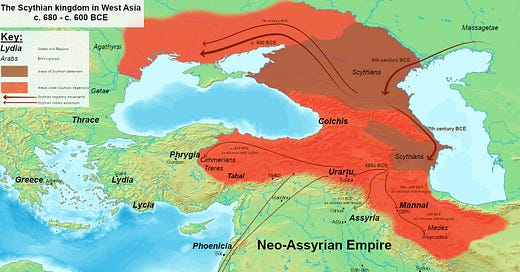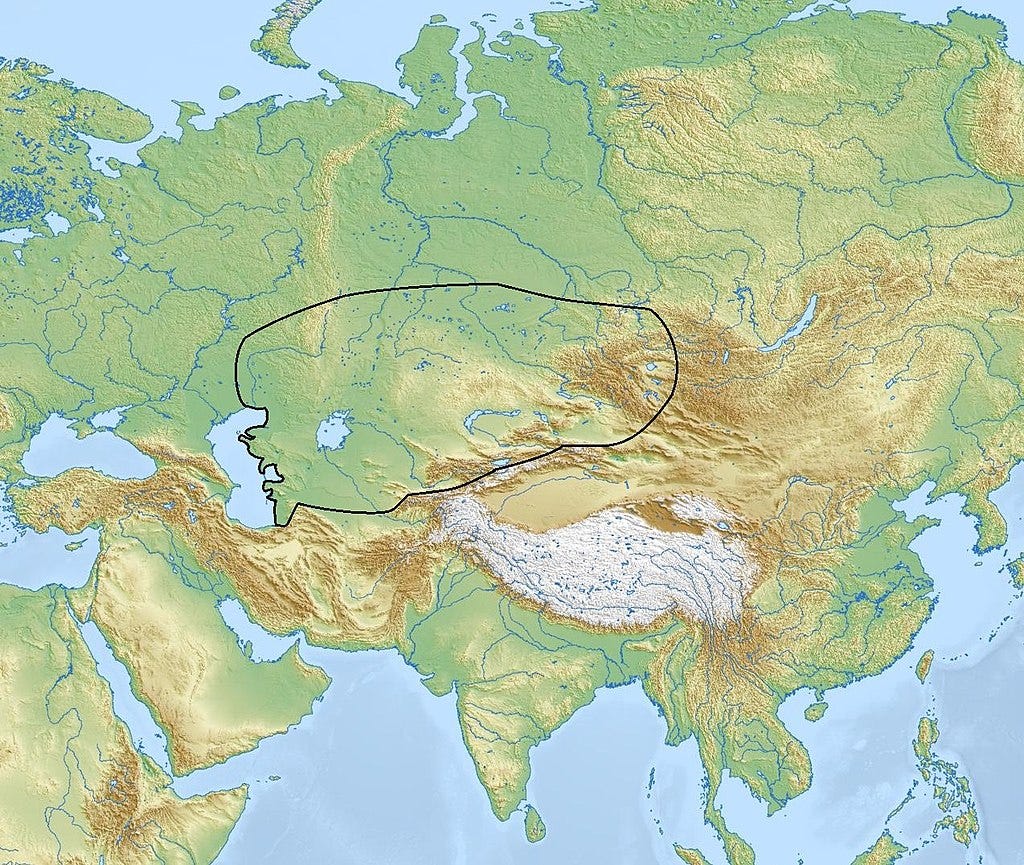Homeland of Japheth
A look into the Scythian Pontic Steppe and it's role in the origin of the Japhetites
The Scythians originated between the Caspian and Pontic sea, north of the Caucasus mountains and south of the extreme frozen north around the 9th century BCE.1 Their primary realm of domination was centered on this area, but they were a migratory, nomadic people and would thus extend their actual kingdom much farther than their central homeland. The Scythians were arguably a dominant superpower in the Iron Age, often clashing with the Empires in Mesopotamia and acting as a counterweight to their expansion. Interesting about the Scythians is their language being Iranian, essentially closely related to Persian. The rise of these two intimately related empires as the global hegemons results in much of the messianic language employed by prophets such as Ezekiel, and Jeremiah.
To ancient people, this entire Eurasian Steppe would be simply referred to as “Scythia”, and therefore their people all considered “Scythian”. Culturally - meaning archaeologically - the Cimmerians and Scythians are nearly identical, but to contemporaries these two groups were distinct from one another ethnically.2 Ultimately the Cimmerians were only a recognizable sub-group of the broader “Scythian” people. A modern example is a nation such as Italy, where each region tends to have their own distinct identities and cultural peculiarities, but all of them would be described as “Italian” to any foreigner. They might notice a difference between the North and South, or specific cities like Venice, but the nuances would be lost in translation. This was often the experience for ancient historians and writers, and still persists today. It is difficult for non-natives to perceive the differences between similar brother groups.
Both the Scythians and Cimmerians were actually part of a wider “Scytho-Siberian World”, an Iron age cultural zone stretching across the Eurasian Steppe all the way from Hungary to Korea. This region included not only the aforementioned groups but also Sarmatians, Sauromatians, Saka, Massagetae, Sogdians, Bactrians, and even Proto-Slavs, Proto-Balts, and the emerging Finno-Ugrian peoples. Most, if not all of these ethnicities, form the basis of modern populations in the region; through centuries of cross-cultural mixing these groups formed their own identities sharing contact with the cultures they border, and oftentimes becoming intermingled with the locals.
While the term “Scythian” was used to describe anyone from “Scythia”, there were well defined groups of culturally distinct Scythians. These are broadly defined as West and East Scythians, with the Eastern Scythian populations being the origin of many of the cultural elements unique to Scythia such as Kurgan mound burials, and Animal art metalworking.3 Genetic studies show both of these populations originated independently of each other around the 1st millennium BCE, prior to the Iron Age, however they both were descended from earlier steppe populations.
Looking at archeological cultures before 1000 BCE there are two broadly defined groups for the East and Western steppe: Timber-Grave culture (often called Srubnaya) and the Andronovo culture. While these cultures had yet to develop many of the traditions affiliated with the Scythians, they were effectively the same people with the Srubnaya comprising the “Western” Scythians and the Andronovo considered “Eastern” Scythian.
Genetic evidence based on studies comparing Iron Age nomadic populations to East Pontic Steppe populations shows continuity between the more ancient Srubnaya culture and the Scythians.4 This essentially makes them forefathers of the Scythians, and considering cultural and linguistic similarities such as their usage of Iranian, and the presence of Iranian hydrological names in the Pontic Steppe, it is extremely evident they are similar, or nearly the same people.5
The vast majority of Srubnaya genetic evidence shows a link between them and the Scythians, but in actuality the Srubnaya are part of the R1a Haplogroup, while most Scythians are R1b Haplogroup.6 This would imply similar to Circassians being a subgroup of Scythians, the Scythians themselves were actually just a closely related people living in a culturally “Srubnaya” region. R1a Srubnaya would roughly correlate to most Eastern Europeans today, such as Poles, Czech, Slovaks Ukrainians, Russians and large populations in Hungary and Croatia. R1b on the other hand mostly correlates to the rest of Europe, countries such as Germany, France, Spain, Portugal, North Italy, Netherlands, Belgium, Britain, Scandinavia (Denmark, Norway, Sweden less so Finland), even Mountain Syrians and large parts of the Balkans including Greece and Turkey.7
Like the Srubnaya culture, the Andronovo similarly has numerous Iranian place names through its horizon, attesting to these people as progenitors of Indo-Iranians. They also share a large proportion of their genetics with the Srubnaya, with studies showing numerous individuals with R1a Haplogroups, essentially correlating to Eastern Indo-Europeans. Much of modern India - about 50% - are genetic descendants of the Andronovo through the Vedic culture of India likely correlating to the “Saka who lay Hauma”.
Those Saka who lay Hauma mentioned in Persian records could therefore be called progenitors for much of modern India, potentially relating them to Gomer. As we see with the genetics of the Andronovo, or “Eastern Scythians”, they correlate more with the R1a populations while the Gomerian-Cimmerians were related to the Saka and Scythians proper who were R1b. Neither the Cimmerian or Scythians are exactly correlated to Andronovo, but they might have shared genetics and mixed culturally at times. This would make an identification for the Andronovo and its related sub-cultures a separate child of Japheth rather than subsumed under Gomer. We can therefore put Indo-Iranians - meaning Vedic Indians and Persian Iranians, but also Kurds, Afghanis, Pakis, Bengalis, and Alans - in a separate grouping from Gomer and his children.
Returning to the R1b Scythians, it is likely both they, the Srubnaya, the Andronovo and the similarly related Sintashta culture all came from the same homeland, and originated as a single people. Both the R1b and R1a populations of Scythians and Srubnaya+Andronovo came from a single ancestor population around the steppe.8 The name given to these people, and their culture is the “Yamnaya”; these are some of the most important people to uncover the backstory for most, if not all Europeans, and may be a potential identification for Japheth.
A map of the Yamnaya homeland is extremely helpful in unraveling the picture of their migrations. As can be seen on the chart, around 3000 BCE these people began migrating out of the Pontic Steppe, and into nearly all of the aforementioned regions. If we were to look at this in branches, the Yamnaya spit into the Corded Ware, Bell Beaker, Srubnaya, Andronovo, Sintasha cultures.9 These names are not important, but from the map it is clear to tell who, and where these populations and cultures spread. Much of the coming sections will deal with unraveling this picture, and discussing the evidence to correlate their future Kingdoms with Biblical nations, and descendants of Noah.
For now what is necessary is that the “Yamanaya” were not a single people, but rather a diverse grouping of familiarly related peoples, who eventually develop their own ethnic differences over the millennia. We could tentatively call Japheth “Yamnaya’s original father”, but by time of these people the Yamnaya were already a large group, so attempting to correlate Japheth to the Yamnaya becomes tenuous and delves into spotty science and deep history. It would therefore be sufficient to place Gomer, the first son of Japheth, as a major steppe tribe inhabiting the homeland region for the Indo-European Yamnaya; and like other migratory tribes who made their way from this homeland only formed their own identity after settling down in distant regions. Gomer is not specifically “The Yamnaya”, but a descendant of these Yamnaya who may, or may not be the direct familial clan of “Japheth”.
I have a personal chart of all the Generations of Noah, but I’ve debated sharing that publicly. I will share the first piece of the chart since I do not see a problem with that, but later on I might paywall this chart at the very end of the post to avoid having my work plagiarized. Some of the later identifications will be quite novel, and that may also create arguments for people, or ethnicities who simply see a name on a chart without reading the correlating information.
No worries, anyone who is subscribed currently will be grandfathered in and will have permanent access even if I ever turn a paywall on.
I hope you enjoyed this weeks post. If you have any suggestions, or criticisms - no matter how minor - don’t be afraid to comment or message me directly. Next week will begin dealing with the three sons of Gomer.
There may, or may not be a supplementary post on the genetics of deep history eventually posted, but I don’t feel comfortable sharing it in an incomplete state. A full discussion of Haplogroups is extremely muddy territory, but I’m comfortable having that conversation in private if someone is interested.
Batty, Roger (2007). Rome and the Nomads: The Pontic-Danubian Realm in Antiquity. Oxford: Oxford University Press. ISBN 978-0-198-14936-1.
Tokhtas’ev, Sergei R. (1991). "Cimmerians". Encyclopædia Iranica.
Unterländer, Martina (March 3, 2017). "Ancestry and demography and descendants of Iron Age nomads of the Eurasian Steppe"
Juras, Anna (March 7, 2017). "Diverse origin of mitochondrial lineages in Iron Age Black Sea Scythians"
Mallory, J. P.; Adams, Douglas Q. (1997). "Srubna Culture". Encyclopedia of Indo-European Culture. Taylor & Francis. pp. 541–542.
Krzewińska, Maja (October 3, 2018). "Ancient genomes suggest the eastern Pontic-Caspian steppe as the source of western Iron Age nomads". Nature Communications.
These are just some of the main places, but interestingly R1b is also found around Lake Chad in Africa.
Narasimhan, Vagheesh M.; et al. (September 6, 2019). "The formation of human populations in South and Central Asia"
Novembre, John (11 June 2015). "Ancient DNA steps into the language debate" (PDF). Nature. 522 (7555): 164–165.












Very interesting. Love the old maps!
Great read as always, Benjamin.